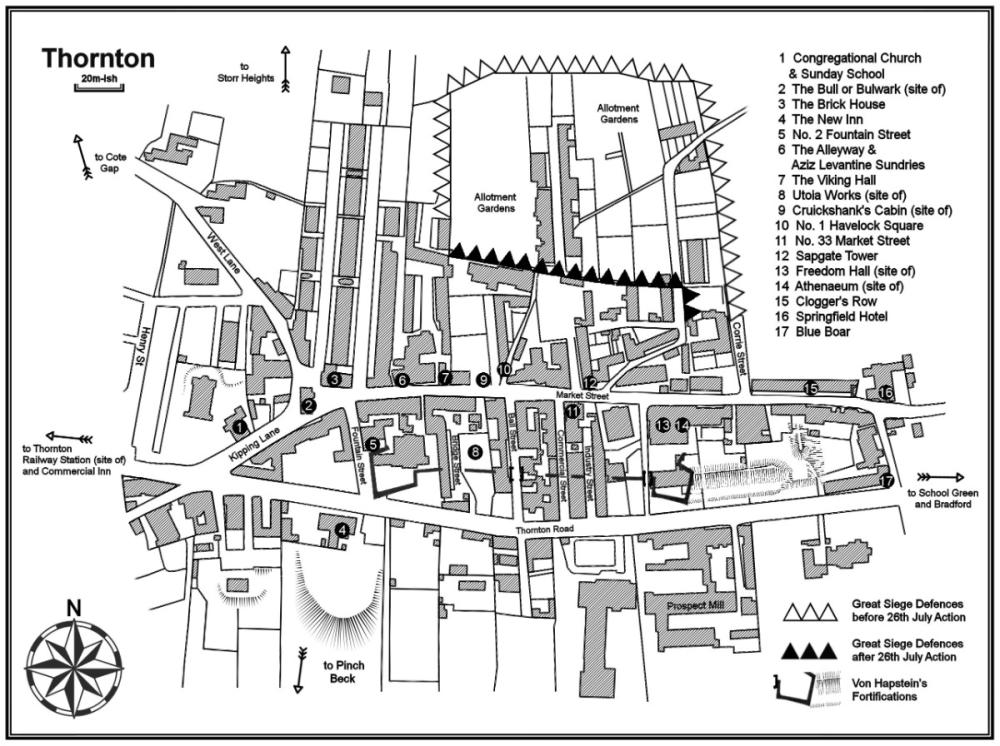search
date/time
 | North East Post Weekend Edition |

Andrew Liddle
Guest Writer
8:09 AM 9th March 2024
arts
A History And A Guide To Thornton - And A Parallel World

All images: Daniel Shiel
Daniel Shiel, a native of Redhill, Surrey, but long-time resident in the West Riding, has just written Thorntichronicon, a crowded history of the village which omits all reference to the Brontës and instead focuses on a gallery of rich and colourful eccentrics and their amazing goings-on.

So far so good. We are going to learn something about one of Bradford’s most appealing suburbs which has changed little in the last 150 years and still retains a village atmosphere!

Daniel is an archaeologist by profession, who acquired his qualifications at Bradford University and has worked for English Heritage. Perhaps he’s dug up something that history has neglected to tell us? He laughs at the suggestion. “Although you could walk round the village using my book as a guide to its streets and major buildings …” He pauses, dramatically. “It is in fact a work of fiction.”
You don’t have to read too much to realise that it is, lock, stock and barrel, the product of a fertile imagination and has no historical substance whatsoever. “I never considered looking into local history or legend,” he continues. “What I’ve written is entirely made up of stories that just filled my head over a twenty-year period.”

On a surreal rollercoaster ride, we encounter such as the formidable warrior Sir Hugh de Thorn, builder of the brooding Sapgate Tower, his conscience aroused by a wicked murderous past. Then there are the well-named ladies of fortune – or ill-fortune – Captains Angelika Drincßenschnax and Erika Haydan Zeick, loveable rogues, permanently at odds with their surroundings, but never losing their sense of humour even in mortal danger.

Though bizarre religious and political fanatics abound in Thornton and the supernatural seems to lurk round every corner, even more bizarrely life appears to go on as usual, as though everything is perfectly normal.
Just to add another layer of mock authenticity, the book is copiously illustrated. Daniel confesses to having worn his other hats as graphic designer and photographic artist, using varying degrees of editing and processing. “I tried to make the illustrations a work of art in themselves,” he laughs. “The portraits consist of photos of friends and work colleagues kind enough, for the sake of art, to have their faces superimposed on images taken in the nineteenth century.”

the Lighthouse
Those who know the New Inn in Thornton may be familiar with ‘The Billiard Room’ by Henry O’Neil, which hangs over the fireplace. Actually, it’s a view of the Garrick Club, in London, but re-imagined as the basement of Thornton Athenaeum. “I worked backwards from it to fit the events and characters depicted into part of the story of the Great Siege. It magically fits so well.”
Apparently, Daniel originally wrote these amazing stories merely to amuse himself. “The idea of calling it a history, drawing all the tales together, came rather late,” he says. “In fact only when I seriously thought about making a book.”
The obvious question is why Thornton. “It’s a place that struck me the first time I saw it, even before I lived and worked in it. I like the way the clusters of stone buildings all hang together and overlap with little regard to property boundaries. I love the streets and winding ginnels and the surprisingly varied industrial architecture.”
He sees the village reinventing itself, thanks to the pride and inventiveness of its people, after industrial decline and years of official neglect and indifference. “The village was once full of thriving shops and businesses, substantial buildings, industrial infrastructure and places of worship.”
Having chosen it as a setting, it seems he simply let the lively imagination of an archaeologist run riot. “Perhaps I have an overactive one,” he considers. “Employing my love of history and interweaving humour with the surreal and bizarre, I somehow imagined single-minded and ingenious people striving in a harsh landscape burdened by ruthless outside powers.”

The irony is that amidst all the absurdity, the slapstick and buffoonery, it says an awful lot about the folly of taking ourselves seriously or believing what we read in books. And, yes, it superbly hits the nail on the head in summing up the character of local people – Pennine people not just Thorntonians!
They are gritty as the local millstone grit and endlessly resourceful.

Daniel Shiel
More information www.danielshiel.com